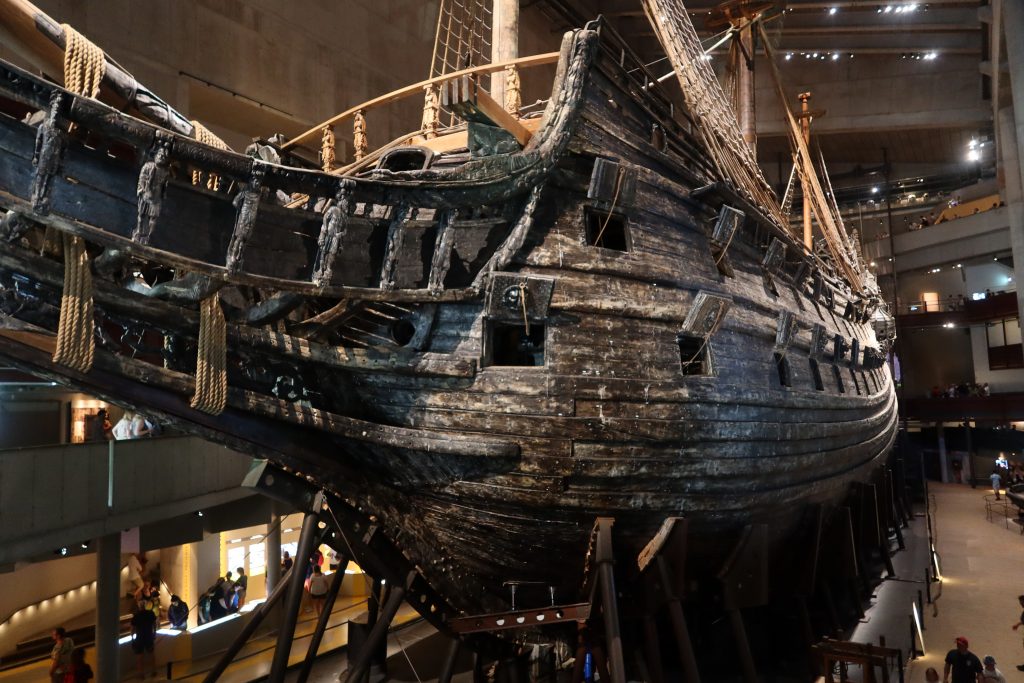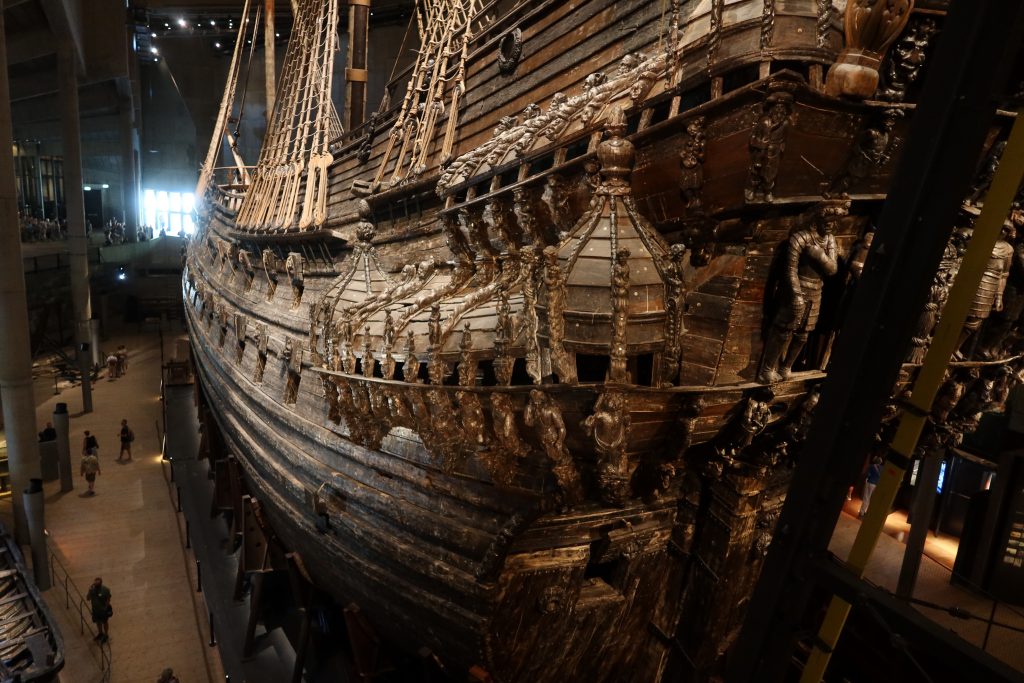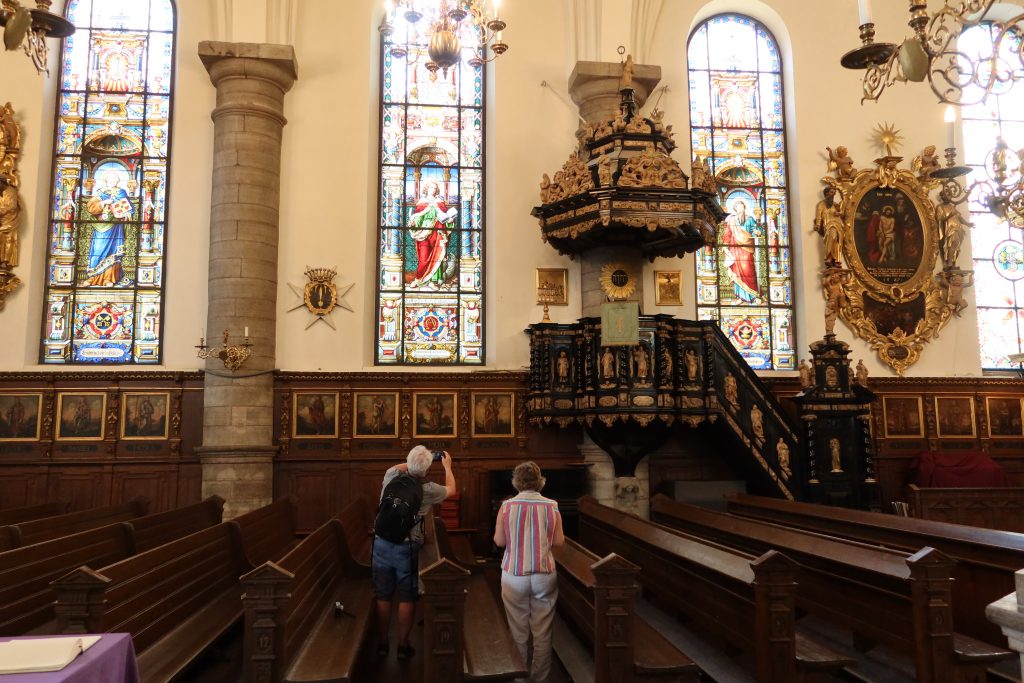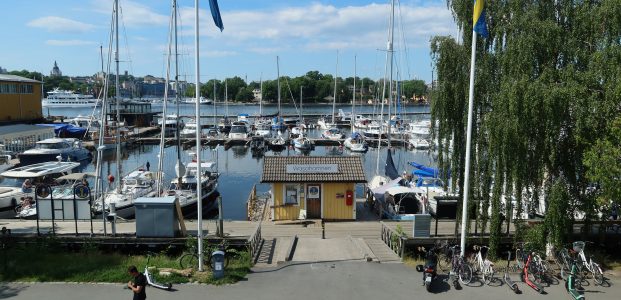After a suitable time to recover from the weirdness of Swedish midsummer rituals, we left Vaxholm, heading for Wasahamnen in Stockholm. This was a short trip – just 11 miles, but we did manage to sail a lot of it, taking the sails down when the wind became too fluky to easily avoid all the ferries and other traffic around Stockholm. We had pre-booked a spot in Wasahamnen in advance so that we knew we would get in and so I knew exactly where I was heading for. The problem was that the gap I was heading for was about two metres wide and our beam is around four metres. So, I embraced my inner Swede and just aimed at it (accompanied by some choice language). There was then a ‘parting of the boats’ as we squeezed in between a Dutch and a German boat leading to an intimacy between Britain and Europe that is long gone politically …
Once there we headed off to one of the most visited museums in Stockholm – the Wasa museum. This could be argued to be a celebratory monument to incompetence. The Wasa took three years to build and was finished in 1628. The builder was a Dutch-born shipwright known as Master Henrik – Henrik Hybertsson. In January 1625, Master Henrik and his business partner Arendt de Groote signed a contract to build four ships, the Wasa being one of them. There is a lot of speculation about what went wrong. It is known that the King ordered seventy-two twenty-four pound guns in 1626 and this may have pressured the builders to add an extra gun deck to accommodate them. Certainly the theoretical principles of shipbuilding and stability were not well understood and it is clear that the centre of gravity of the Wasa was far too high. As a result, just 1,400 yards into her maiden voyage to the naval station at Älvsnabben she was caught by a gust and capsized. Water flooded through the gun ports making her unstable and she quickly sank taking thirty of the crew to their deaths with her.
There were attempts to salvage her immediately after she sank and most of the cannons were recovered, but the attempts to raise the hull were unsuccessful and eventually the location of the hull got lost in the mists of time. It wasn’t until the early 1950s that an amateur archaeologist – Anders Franzen – started looking for the wreck again. He reasoned that it would be well preserved in the cold brackish waters of the Baltic because, the shipworm Teredo navalis, which usually rapidly destroys submerged wood in warmer, saltier seas cannot survive. In 1956 he discovered a large wooden object using a home-made, gravity-powered coring probe. He had found the Vasa …
As soon as it was confirmed to be the Vasa, planning started on how to raise her. Various schemes were proposed and the most outlandish was a plan to fill the ship with ping-pong balls and freeze it in a block of ice. For some reason this wasn’t the chosen approach (perhaps it arrived on April 1st!) and so divers spent two years digging tunnels under the ship for steel hawsers. These were then taken to two floating pontoons and she was gradually raised to the surface a metre at a time. On the morning of 24 April 1961, the Vasa finally returned to the surface for the first time in 333 years. She moved into her current home in 1988.

Her state of preservation is remarkable and archaeologists have spent years painstakingly removing and cataloguing the contents of the ship – items range from a backgammon set to a chest of carpenter’s tools. This has given perhaps the most complete picture of what life was like on a ship in the 17th century. The most remarkable find though when they lifted the Vasa was a statue of the 20th-century Finnish runner Paavo Nurmi. This may appear some sort of Back to the Future moment, but in fact, the statue was placed there as a prank by students of Helsinki University of Technology the night before the final lift. The statue remains among the catalogued artefacts! Calling it a prank though belies the deep-seated resentment that exists between Sweden and Finland over Paavo Nurmi. Nurmi had won nine gold medals in the previous three Olympics, but was barred from competing in the 1932 Olympics on what the Finns considered ‘trumped-up’ charges. As a result Finland cut off all sporting cooperation with Sweden and this ‘prank’ makes it clear that they haven’t forgotten it.

June 26th
The next day we explored Stockholm a little further and in the morning went to the new shipwreck museum right by Wasahamnen – Vrak. The ground floor of the museum was taken up with an intriguing immersive film and then a focus on a wreck called the Resande Man – the Travelling Man. This wreck was discovered in 2012. It sank in a storm in the Stockholm archipelago in November 1660. It was headed for Poland on a diplomatic mission and only half of those on board survived when it went down. It started from Dalarö and it would appear that the pilot was ill, but the diplomatic mission was considered of such importance that the Captain headed off without a pilot – an ominous start … The ship then anchored at Landsort to try to wait out a storm, but the storm doesn’t let up quickly and the anchor starts to drag. The rest, as they say, is history … The ship is a protected wreck so many of the finds have simply been catalogued and left on the wreck site. The museum cleverly showed these as a projection of the item with film of the site showing where they were found.
We then met Hugh and Liz on Gamla Stan (the Old Town) for lunch – they had been looking round the photographic museum in the morning. The afternoon was spent wandering around the main cathedral and then the German Church. The German Church (known as St. Gertrude’s – the Patron Saint of travellers) was built for the many German merchants who traded in Stockholm, giving them somewhere to worship in their own language and with their own traditions. Services in German still take place every week.

In the evening it was time for Liz and Hugh to fly home – the end of a very entertaining week.

